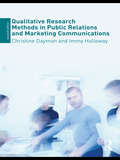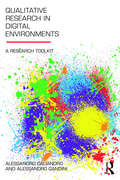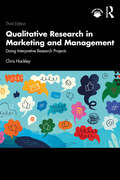- Table View
- List View
Qualitative Marketing Research: Understanding Consumer Behaviour
by Dominika MaisonThis is a perfect guide to understanding the core principles of qualitative marketing research. It presents qualitative marketing research in the broader context of marketing and managerial decisions, consumer psychology and contemporary knowledge about unconscious and automatic processes. Different types of qualitative marketing research methods are examined, from the classic focus group interview (FGI) and individual in-depth interview (IDI), to more cutting-edge methods such as ethnography or bulletin boards, which enable marketing researchers to discover and understand real consumer motivations, needs, values, and attitudes. With numerous international case studies, including PepsiCo, Unilever, Danone, Nestle, Aviva and Citibank, the book is uniquely practical in its approach. It is vital reading for advanced undergraduate and postgraduate students of marketing research, consumer behaviour and consumer psychology.
Qualitative Markt- und Konsumforschung: Einführung und Praxis-Handbuch (Konsumsoziologie und Massenkultur)
by Thomas Kühn Kay-Volker KoschelDie Autoren Thomas Kühn und Kay-Volker Koschel geben in diesem Buch eine praxisnahe Einführung in Grundgedanken und Methoden der qualitativen Markt- und Konsumforschung. Zur Veranschaulichung werden zahlreiche Praxisbeispiele gegeben und typische Fehler bei der Konzeption typischer Studien identifiziert und Lösungsmöglichkeiten angeboten.
Qualitative Methods for Health Research (Introducing Qualitative Methods)
by Dr Nicki Thorogood Dr Judith GreenThe Third Edition of this bestselling title is packed full of real-world advice for researchers and students. It is an invaluable introduction to the theoretical and practical essentials needed to design, conduct and appraise qualitative research in health. The book highlights core research skills, taking the reader through the key debates in qualitative methodology. It sets out a logical, easy-to-follow path supported by practical examples ensuring you will find it engaging and relevant. Updates for the new edition include: - a new chapter on effectively combining methods - new material on the practical aspects of securing access to participants, using online data and on selecting an approach for analysis - improved material on reading and appraising literature with detailed exploration of systematic reviews and synthesis - expanded chapters on analysing data, with practical suggestions for moving from descriptive to analytical approaches - an effective mix of classic and contemporary case studies from across health research - expanded summaries, key points and reflective questions designed to help students apply theory to their own research. Clear, thorough and articulate, this is an authoritative introduction to qualitative research for all health professionals and students. Visit the accompanying companion website for additional resources. Judith Green is a Professor in Sociology of Health at the London School of Hygiene and Tropical Medicine. Nicki Thorogood is a Senior Lecturer in Sociology at the London School of Hygiene and Tropical Medicine.
Qualitative Methods in Business Research
by Päivi Eriksson Anne Kovalainen`Comprehensive, current and compelling, a winning combination for any research student or practitioner interested in increasing his/her knowledge about qualitative methods as they apply to business research' - The Qualitative Report Covering all the major qualitative approaches in business studies (including case study research, ethnography, narrative inquiry, discourse analysis, grounded theory and action research), this practical how-to guide shows how qualitative methods are used within management, marketing, organizational studies and accounting. Within each approach, the authors consider crucial issues such as framing the research, generating research questions, getting access, collecting empirical materials, reporting the results and evaluating the research. Original case studies drawn from around the world are included throughout to demonstrate the practical applications of the methods discussed.
Qualitative Methods in Business Research: A Practical Guide to Social Research (Introducing Qualitative Methods)
by Päivi Eriksson Anne Kovalainen<p>This pragmatic, applied textbook showcases the potential and impact of qualitative research in business and management. Using case studies and a global approach it provides you with an overview of the philosophies, methodologies and methods you will need to research in this field. <p>Demystifying the whole process, it walks you through every aspect of conducting and using research in business, including generating questions, collecting useful data, evaluating the research and disseminating your findings. It also: <p>Explores the challenges of working with qualitative data Introduces qualitative methods including interviews, focus groups & ethnography <p>New to the 2nd edition: <p> <li>The role of digital tools and social media, and how you can use them for data collection <li> 3 new chapters on qualitative content analysis, visual research and publishing research. </li>
Qualitative Methods in Business Research: A Practical Guide to Social Research (Introducing Qualitative Methods)
by Päivi Eriksson Anne KovalainenThis pragmatic, applied textbook showcases the potential and impact of qualitative research in business and management. Using case studies and a global approach it provides you with an overview of the philosophies, methodologies and methods you will need to research in this field. Demystifying the whole process, it walks you through every aspect of conducting and using research in business, including generating questions, collecting useful data, evaluating the research and disseminating your findings. It also: Explores the challenges of working with qualitative data Introduces qualitative methods including interviews, focus groups & ethnography New to the 2nd edition: The role of digital tools and social media, and how you can use them for data collection 3 new chapters on qualitative content analysis, visual research and publishing research.
Qualitative Methods in Economics (Routledge Frontiers of Political Economy)
by Mirjana Radović-Marković Beatrice Avolio AlecchiDespite numerous books on research methodology, many have failed to present a complete, hands-on, practical book to lead college classes or individuals through the research process. We are seeing more and more scientific papers from all research fields that fail to meet the basic criteria in terms of research methods, as well as the structure, writing style and presentation of results. This book aims to address this gap in the market by providing an authoritative, easy to follow guide to research methods and how to apply them. Qualitative Methods in Economics is focused not only on the research methods/techniques but also the methodology. The main objective of this book is to discuss qualitative methods and their use in economics and social science research. Chapters identify several of the research approaches commonly used in social studies, from the importance of the role of science through to the techniques of data collection. Using an example research paper to examine the methods used to present the research, the second half of this book breaks down how to present and format your results successfully. This book will be of use to students and researchers who want to improve their research methods and read up on the new and cutting edge advances in research methods, as well as those who like to study ways to improve the research process.
Qualitative Mitarbeiterbefragungen: Grundzüge und Praxisleitfaden für den Einsatz in der Organisationsentwicklung (essentials)
by Christian Schmidt Thomas KühnGrundzüge qualitativer Mitarbeiterbefragungen werden zusammengefasst und mit einem Leitfaden für die Durchführung verbunden. Angesichts beschleunigten sozialen Wandels und insbesondere digitaler Transformationsprozesse steigt der Bedarf nach Organisationsentwicklung. Für Mitarbeiter*innen ist dies mit Unsicherheit auf verschiedenen Ebenen verbunden. Um Resignation und Polarisierungen in Teams entgegenzuwirken, ist es wichtig, Mitarbeiter*innen zu befragen und auf dieser Grundlage systematisch in Transformationsprozesse einzubinden. Qualitative Verfahren bieten aufgrund der Offenheit der Befragung hier entscheidende Vorteile gegenüber standardisierten Instrumenten.
Qualitative Research Approaches for Public Administration
by Larry S. LutonThoroughly updated, more concise than the previous edition, and available for the first time in paperback,
Qualitative Research Methods In Business: Techniques for Data Collection and Analysis
by José Osvaldo De SordiThe challenges of developing research and generating scientific knowledge in environments that involve subjective aspects related to employees, customers, managers, leaders, inspectors, auditors, among other stakeholders in the business environment, can be overwhelming for students that are new to this type of inquiry. This textbook presents an integrated view of qualitative research strategies with data collection and analysis techniques.The book explores nine distinct research strategies, namely ethnography, phenomenology, grounded theory, case study, design science research, grounded design, action research, participatory action research, and action-design research.Related to data collection, this text discusses different types of qualitative interviews (focus groups, ethnographic, phenomenological, etc), as well as how to handle ethical issues that may arise.In terms of analyzing data, the author describes various reading techniques, how to code the text, and how to use software to aid in the analysis.The final section of the book explains how to write up the results of qualitative research, including article structure and selecting an outlet for publication.Students will benefit from the plentiful examples and exercises that highlight the interweaving of data collection and analysis as well as concrete guidelines on engaging in qualitative research. At a time in which qualitative research is becoming more rigorous to meet the demands of the field, this textbook will prove a valuable resource for the next generation of business researchers.The English translation of this book from its Portuguese original manuscript was done with the help of artificial intelligence (machine translation by the service provider DeepL.com). A subsequent human revision of the content was done by the author.
Qualitative Research Methods for Business Students: A Global Approach
by Christian Harrison Kingsley Obi OmeiheQualitative Research Methods for Business Students: A Global Approach provides a practical and accessible overview of qualitative research methods and their philosophical underpinnings. The textbook will empower you with the knowledge and skills needed to navigate the dynamic landscape of qualitative research. Key features include: Case Studies which showcase how qualitative research has been instrumental in shaping business decisions and strategies. Exercises and Activities that give you the opportunity to apply your learning. Suitable for undergraduate and postgraduate students interested in using qualitative methods in their research project or dissertation. Dr Kingsley O. Omeihe is an Associate Professor for Marketing and Small Business at the University of the West of Scotland Prof Christian Harrison is a Professor of Leadership and Enterprise at the University of Bolton.
Qualitative Research Methods for Business Students: A Global Approach
by Christian Harrison Kingsley Obi OmeiheQualitative Research Methods for Business Students: A Global Approach provides a practical and accessible overview of qualitative research methods and their philosophical underpinnings. The textbook will empower you with the knowledge and skills needed to navigate the dynamic landscape of qualitative research. Key features include: Case Studies which showcase how qualitative research has been instrumental in shaping business decisions and strategies. Exercises and Activities that give you the opportunity to apply your learning. Suitable for undergraduate and postgraduate students interested in using qualitative methods in their research project or dissertation. Dr Kingsley O. Omeihe is an Associate Professor for Marketing and Small Business at the University of the West of Scotland Prof Christian Harrison is a Professor of Leadership and Enterprise at the University of Bolton.
Qualitative Research Methods in Consumer Psychology: Ethnography and Culture
by Paul HackettWhile consumer research is founded on traditional quantitative approaches, the insight produced through qualitative research methods within consumer settings has not gone unnoticed. The culturally situated consumer, who is in intimate dialogue with their physical, virtual and social surroundings, has become integral to understanding the psychology behind consumer choices. This volume presents readers with theoretical and applied approaches to using qualitative research methods in ethnographic studies looking at consumer behavior. It brings together an international group of leading scholars in the field of consumer research, with educational and professional backgrounds in marketing, advertising, business, education, therapy and health. Researchers, teaching faculty, and students in the field of consumer and social psychology will benefit from the applied examples of qualitative and ethnographic consumer research this volume presents.
Qualitative Research Methods in Public Relations and Marketing Communications
by Immy Holloway Christine DaymonThe second edition of this highly accessible, core textbook continues to offer students a practical guide to the process of planning, undertaking and writing about qualitative research in public relations and marketing communications. Through clear explanations and illustrations, the book encourages undergraduate and master level students to engage with the main approaches and techniques for conducting critical, reflective investigations. This new edition: Identifies the skills and strategies needed to conduct authentic, trustworthy research Highlights specific analytical techniques associated within the main research approaches Provides new sections on internet-based research, critical discourse analysis, historical research, action research and mixed methods research Qualitative Research Methods in Public Relations and Marketing Communications will be invaluable for those undertaking research methods courses on public relations and marketing communication degrees, as well as those working on a dissertation.
Qualitative Research from Start to Finish
by Robert YinThis lively, practical text presents a fresh and comprehensive approach to doing qualitative research. The book offers a unique balance of theory and clear-cut choices for customizing every phase of a qualitative study. A scholarly mix of classic and contemporary studies from multiple disciplines provides compelling, field-based examples of the full range of qualitative approaches. Readers learn about adaptive ways of designing studies, collecting data, analyzing data, and reporting findings. Key aspects of the researcher's craft are addressed, such as fieldwork options, the five phases of data analysis (with and without using computer-based software), and how to incorporate the researcher's "declarative" and "reflective" selves into a final report. Ideal for graduate-level courses, the text includes Discussions of ethnography, grounded theory, phenomenology, feminist research, and other approaches. Instructions for creating a study bank to get a new study started. End-of-chapter exercises and a semester-long, field-based project. Quick study boxes, research vignettes, sample studies, and a glossary. Previews for sections within chapters, and chapter recaps. Discussion of the place of qualitative research among other social science methods, including mixed methods research.
Qualitative Research in Business & Management
by Michael D. MyersWhat are the key issues that concern Qualitative Research in Business and Management? In this advanced textbook, the author brings a wealth of insight to the research process. Combining the abstract and theoretical considerations with those of a practical nature, like those involved with interviewing for data, or for the final stage of writing up, Myers establishes an expansive resource for those involved in qualitative research that will aid them from start to finish. In this book the reader will be provided with the resources to: - Understand the underlying philosophies of qualitative research in business and management. - Be aware of a variety of qualitative research methods - Gain insight into examples of the previous use of qualitative methods in Business and Management. - Analyse and critically evaluate research in, including discussion of using qualitative data analysis software. - Carry out their own research in business and management. - Write up their research for publication. This book will be an indispensable resource both to those just embarking on their research as well as existing researchers in business and management.
Qualitative Research in Business and Management
by Dr Michael D. MyersAn expansive, yet remarkably concise and accessible resource, Qualitative Research in Business and Management is designed to help qualitative researchers with all aspects of their research project from start to finish. It discusses the key philosophies underpinning qualitative research and design in business and management, and assesses the advantages and disadvantages of the different approaches.<P> Key features include:<P> * Case studies, exercises, further reading and examples from first-tier journals<P> * An enhanced Companion Website including journal articles and weblinks<P> * Chapters on writing up research and how to get your research published.<P> Visit the Companion Webiste at www.sagepub.co.uk/myers2e
Qualitative Research in Business and Management
by Michael D MyersThis accessible, comprehensive yet remarkably concise textbook is designed to help students and researchers in business and management with their research project. It covers key qualitative research methods, data collection techniques and explores how to analyse qualitative data, before providing invaluable advice on how to write up your research and get published. Now in its fourth edition, Qualitative Research in Business and Management has been updated to reflect the growing popularity of online research and secondary data collection, with new content on AI, the digitalization of qualitative research and virtual fieldwork. Michael D. Myers is Professor of Information Systems in the Department of Information Systems and Operations Management at the University of Auckland Business School, Auckland, New Zealand.
Qualitative Research in Business and Management
by Michael D MyersThis accessible, comprehensive yet remarkably concise textbook is designed to help students and researchers in business and management with their research project. It covers key qualitative research methods, data collection techniques and explores how to analyse qualitative data, before providing invaluable advice on how to write up your research and get published. Now in its fourth edition, Qualitative Research in Business and Management has been updated to reflect the growing popularity of online research and secondary data collection, with new content on AI, the digitalization of qualitative research and virtual fieldwork. Michael D. Myers is Professor of Information Systems in the Department of Information Systems and Operations Management at the University of Auckland Business School, Auckland, New Zealand.
Qualitative Research in Business and Management
by Professor Michael D MyersThis accessible and expansive, yet remarkably concise textbook is designed to help readers with their research project. As well as guiding them through the key methods of collecting and analysing qualitative data, this book provides invaluable information on writing up their research and how to get published. Now in its third edition, Qualitative Research in Business and Management has been fully updated to include a range of recent examples of aspects of qualitative research in action, and a new look at the methods and ethics of using social media data.
Qualitative Research in Business and Management
by Professor Michael D MyersThis accessible and expansive, yet remarkably concise textbook is designed to help readers with their research project. As well as guiding them through the key methods of collecting and analysing qualitative data, this book provides invaluable information on writing up their research and how to get published. Now in its third edition, Qualitative Research in Business and Management has been fully updated to include a range of recent examples of aspects of qualitative research in action, and a new look at the methods and ethics of using social media data.
Qualitative Research in Digital Environments: A Research Toolkit
by Alessandro Gandini Alessandro CaliandroThis book offers a toolkit of methods and technologies to undertake qualitative research on digital spaces. Unlike commonly used traditional methodological strategies, which are ‘retrofitted’ to digital spaces, Qualitative Research in Digital Environments offers researchers a set of ‘digitally native’ tools that are designed for online social environments. Thanks to a broad range of cases including Louis Vuitton, YouTube and the concept of ‘hipsterism’, this text illustrates the practical applications of techniques and tools over the most popular social media environments. This book will be a valuable guide to qualitative research for marketing students, researchers and practitioners, as well as a central reference point for tutors in the growing field of Digital Sociology.
Qualitative Research in Marketing and Management: Doing Interpretive Research Projects
by Chris HackleyThis is a practical and accessible, yet sophisticated introduction to interpretive methods for doing qualitative research projects and dissertations. Bringing together concepts of qualitative research from ethnography, phenomenology, critical discourse analysis, semiotics, literary analysis, postmodernism and poststructuralism this textbook offers an accessible and comprehensive introduction to the subject. Utilising a uniquely pragmatic approach, it bridges the gap between advanced, specialised books on research traditions with more general introductory business research books. This new edition has been fully updated to include new examples, explorations of the field, and an improved pedagogy with better exposition of key issues and concepts, as well as more schematics and diagrams to aid understanding. The first half of the book considers the practicalities of research and writing a research project, including the craft of academic writing, the critical literature review, the role of the independent research project as part of university courses, suggested projected structures, standards of academic scholarship, and the main techniques for gathering qualitative data. The book’s second half deals with abstract concepts and advanced theory by looking at key theoretical traditions that guide the interpretation of qualitative data. It is perfect for advanced undergraduate and postgraduate students of marketing, management, consumer behaviour and research methods. It will also be useful as a primer for practitioners in qualitative research.
Qualitative Research in Marketing and Management: Doing Interpretive Research Projects
by Chris HackleyThis is a practical and accessible introduction to interpretive methods for doing qualitative marketing and management research projects.Bringing together concepts of qualitative research from ethnography, digital ethnography, phenomenology, assemblage theory, critical discourse analysis, semiotics, literary analysis, practice theory, postmodernism, poststructuralism and other areas, it has a uniquely pragmatic approach. The book bridges the gap between advanced, specialised books on research traditions with more general introductory business research books. The first half of the book considers the practicalities of research and writing a research project, including the craft of academic writing, the critical literature review, the role of the independent research project as part of university courses, suggested projected structures, standards of academic scholarship, and the main techniques for gathering qualitative data. The book’s second half deals with abstract concepts and advanced theory by looking at key theoretical traditions that guide the interpretation of qualitative data. This third edition has been fully updated to include new examples, insights from recent research, and an improved pedagogy for logic and clarity throughout, as well as more graphics, diagrams, chapter summaries and exercises to aid understanding.It is perfect for advanced undergraduate and postgraduate students of Marketing, Management, Consumer Behaviour and Research Methods.Online resources include PowerPoint lecture slides.
Qualitative Research in Sport Management
by James Skinner Allan Edwards Aaron C.T. SmithGood qualitative research can help sport management researchers and industry professionals solve difficult problems and better understand their organisations, stakeholders and performance. Now in a fully revised and extended new edition, this book is a user-friendly introduction to qualitative methods in sport management. Covering the full research process from research planning to reporting results, this edition includes expanded coverage of cutting-edge areas including digital and social media research, critical realism, and social network analysis. The book examines the reflective and interrogative processes required for developing effective qualitative research questions and includes a deeper discussion of ontology and epistemology in the light of today’s rapidly changing society. It takes the reader step-by-step through essential and emerging qualitative methods, from actor network theory and ethnography to computer-assisted data analysis and sampling typologies. Every chapter includes examples of real qualitative research, including shorter "research briefs" and extended case studies, reflecting the exciting qualitative research that is currently occurring in sport business and management, and highlighting the links between research and sport management practice. This is essential reading for courses in sport management, sport business, sport policy, sport marketing, sport media, and communications. It provides students, researchers, and practitioners with the knowledge and skills to undertake qualitative research while deepening their understanding of how the social world can be perceived and interpreted through a particular theoretical lens. Useful online materials include recommended readings and PowerPoint slides.




















